Boletus L.
Recent molecular studies have shown that Boletus in its current circumscription is likely an artificial grouping and it is possible that it will be split at some point into smaller genera. Note that Boletus impolitus and Boletus depilatus for practical reasons are retained here, although there is strong evidence that they are closely related to Xerocomus subtomentosus and its allies.
Fruitbody large to medium sized, boletoid, without veil and ring. Stipe solid, with surface usually covered with granules or network. Flesh variously coloured, changing or not when exposed to air. Tubes easily separable from each other, not tearing apart. Pores usually small and rounded.
Boletus permagnificus Pöder
Description
Pileus up to 8 cm, convex to flat-convex, felted or smooth, orange red, vivid to dark red, blueing strongly when bruised, cap margin irregularly undulate. Stipe cylindric, swollen or tapering, more or rooting, light yellow or yellow, downwards reddish white to pale red, dark red or violet brown at the same base, with well developed red network, stipe surface quickly and strongly blueing at the slightest touch. Flesh yellowish, blueing strongly when exposed to air, then fading to dingy, finally (a few hours after cutting) reddening. Tubes yellow, blueing when injured. Pores orange red or orange yellow, paler at the cap margin, blueing when bruised. Smell not distinctive. Taste acid. Spores 13–16 × 5.5–6.5 μm, ratio 2.2–3.0. Pileipellis (the cap cuticle) a trichoderm of interwoven branched septate long cylindrical hyphae, the underlying layers composed of hyphae of shorter and loosely connected cells. Microchemical reactions: no reaction with Melzer’s solution.
Habitat. Warm deciduous forests, mycorrhizal with oaks (Quercus).
Distribution. Distinctly southern species that might be under-recorded. So far known from Bulgaria, Corsica, Greece, Italy, Sardinia and Spain. In the east it reaches as far as Israel.
Photographs
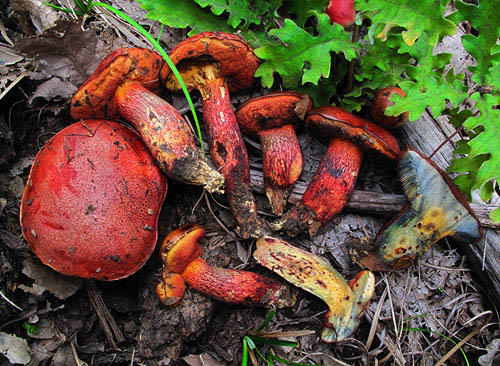
Rich collection of Boletus permagnificus. (photo G. Konstantinidis)
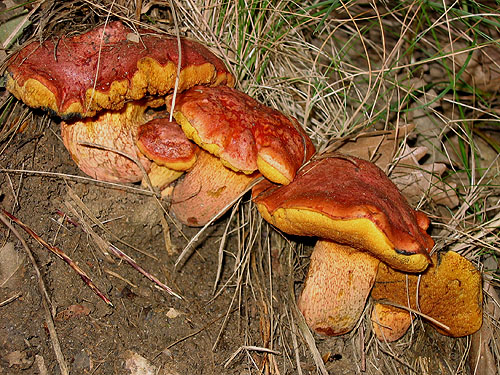
Fruitbodies of Boletus permagnificus in different stages of development. (photo B. Assyov)
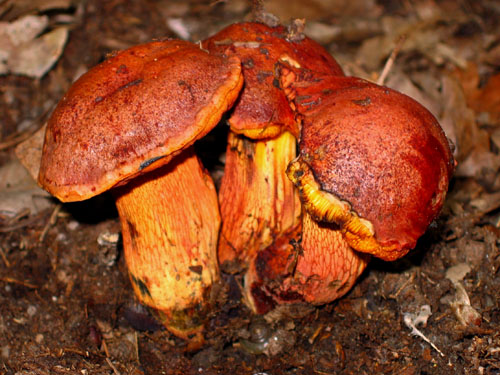
Fruitbodies of Boletus permagnificus. (photo B. Assyov)
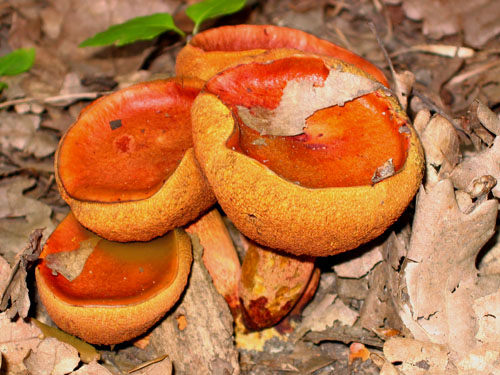
Fruitbodies of Boletus permagnificus. Note the typically clustered habit. (photo B. Assyov)
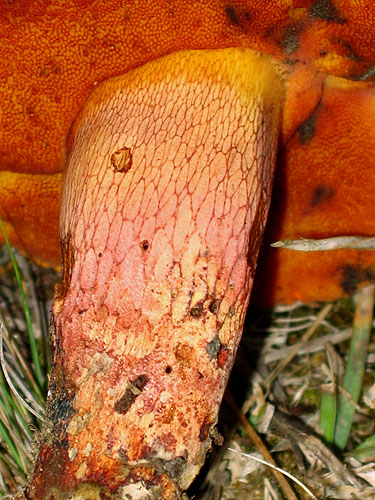
Detail of the stipe surface of Boletus permagnificus. Note the well developed network. (photo B. Assyov)
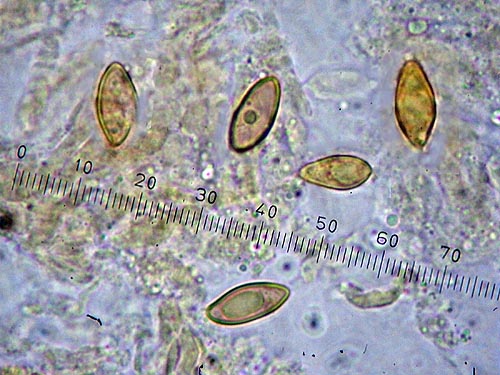
Basidiospores of Boletus permagnificus. (photo G. Konstantinidis)
Important literature
Alessio, C.L. 1984. Boletus siculus Inz e Boletus permagnificus Pöeder. – Micologia Italiana. 1: 63–68.
Assyov, B. 2005. New and rare Bulgarian boletes. – Mycologia Balcanica 2: 75–81. (available online)
Bellù, F. 1986. Ancora su Boletus permagnificus e Boletus siculus. – Bollettino del Gruppo Micologico ‘G. Bresadola’ Trento 29(1-2): 75–79.
Estadès, A. & Lannoy, G. 2004. Les bolets européens. – Bulletin Mycologique et Botanique Dauphiné-Savoie 44(3): 3–79.
Galli, R. 1998. I Boleti. Atlante pratico-monographico per la determinazione dei boleti. Edinatura, Milano.
Icard, C. & Hurtado, C. 1997. Boletus permagnificus Pöder au pied des Alpes. – Bulletin Semestriel de la Fédération des Associations Mycologique Méditérraneennes 12: 5–10. (available online on site)
Lannoy, G. & Estadès, A. 2001. Les Bolets. Flore mycologique d’Europe. Documents Mycologiques Mémoire Hors série no. 6. Pp. 1–163. Association d’Écologie et de Mycologie, Lille.
Lunghini, D. & Perrone, L. 2002. Contributo alla studio e al monitoraggio delle Boletaceae del litorale Laziale. 2. – Bolletino dell’Associazione Micologica ed Ecologica Romana 17–18: 39–60.
Moreno, G. & Esteve-Raventós, F. 1988. Boletus aemilii Barbier, B. permagnificus Pöder and Xerocomus truncatus Singer, Snell & Dick, in Spain. – Lazaroa 10: 253–258. (available online)
Muñoz, J.A. 2005. Boletus s. l. – In: Fungi Europaei. Vol. 1. Pp. 1–951. Edizioni Candusso, Alassio.
Muñoz Sánchez, J.A. & Cadiñanos, J.A. 2001. Algunos Boletales interesantes de la Península Ibérica. – Bellara 17–18: 55–64. (available online)
Pöder, R. 1982. Boletus permagnificus spec. nov. – ein auffallender Röhrling der Sektion Luridi Fr. assoziiert mit Eichen. – Sydowia 34: 149–156. (available online, 5.9 Mb PDF)
Šutara, J., Mikšík, M. & Janda, V. 2009. Hřibovité houby. Čeled’ Boletaceae a rody Gyrodon, Gyroporus, Boletinus a Suillus. Academia, Praha.
Κωνσταντινίδης, Γ. 2009. Μανιτάρια, φωτογραφικός οδηγός μανιταροσυλλέκτη. Αυτοέκδοση, Αθήνα. [Konstantinidis, G. 2009. Mushrooms, a photographic guide for collectors. Published by the author, Athens.]